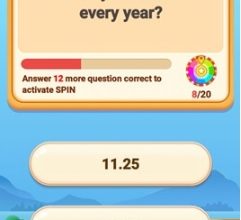Astronomers predict that a comet similar to Halley’s that orbits once every 71.3 years would be simpler to see when it passes past bright stars.

Astronomers predict that in the next weeks, a comet bigger than Mount Everest may be visible to the unaided eye as it begins its first journey through the inner solar system in over 70 years.
The frozen object is a comet of the Halley type, which means it will appear once or maybe twice in a lifetime. In fact, 12P/Pons-Brooks, as it is called, completes its orbit once every 71.3 years, and on April 21 it is scheduled to come closest to the sun.
It is named after the French astronomer Jean-Louis Pons, who found it in 1812, and the British-American astronomer William Robert Brooks, who detected it on its next orbit in 1883. However, other stories claim that 12P/Pons-Brooks was noticed as early as the 14th century.
It is categorized as a cryovolcanic comet, which means that as pressure builds up within as it becomes heated, it explodes with dust, gases, and ice. Its nucleus is thought to be about 30 km (20 miles) in diameter.
During one such eruption last year, the surrounding haze developed a horned shape, causing it to shine a hundredfold and earning it the nickname “the Devil Comet.”
Even while the comet has already been seen in the night sky, with its green tint, astronomers predict that it will only become brighter over the next several weeks. Astrophysicist Dr. Paul Strøm of the University of Warwick said, “The comet is expected to reach a magnitude of 4.5 which means it ought to be visible from a dark location in the UK.”
The comet travels from the Andromeda constellation to Pisces. It will be easier to see on certain days when it passes past brilliant stars along the way. Specifically, 12P/Pons-Brooks will be only 0.5 degrees away from the brilliant star known as Hamal on March 31, he added.
Nevertheless, even if the comet did become brighter, it may still be hard to spot, according to Dr. Robert Massey, deputy executive director of the Royal Astronomical Society. He added that simple tools like tiny telescopes would be very helpful.
“Definitely try to look for it with a half-decent pair of binoculars,” Massey said, adding that sky mapping tools were also helpful.
Right now, the northern hemisphere offers the finest views of the comet. If one was interested in catching a peek, Massey advised going outside on a clear evening and scanning low to the west-north-west as dusk was falling. “You want to stay away from light pollution, moonlight, and hazy conditions.”
According to Strøm, comets and asteroids are often thought of as the solar system’s unutilized building pieces since they provide details about the circumstances under which it created.
Seeing a comet that had only been seen a few times since its official discovery was also a source of gratification, according to Massey. He said, “That’s quite a nice thing to reflect on in and of itself.”


